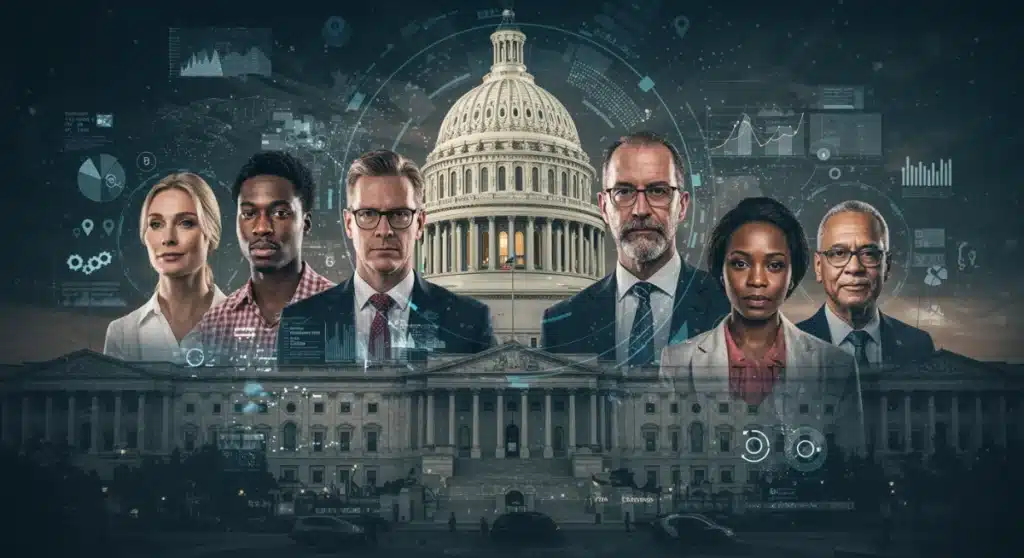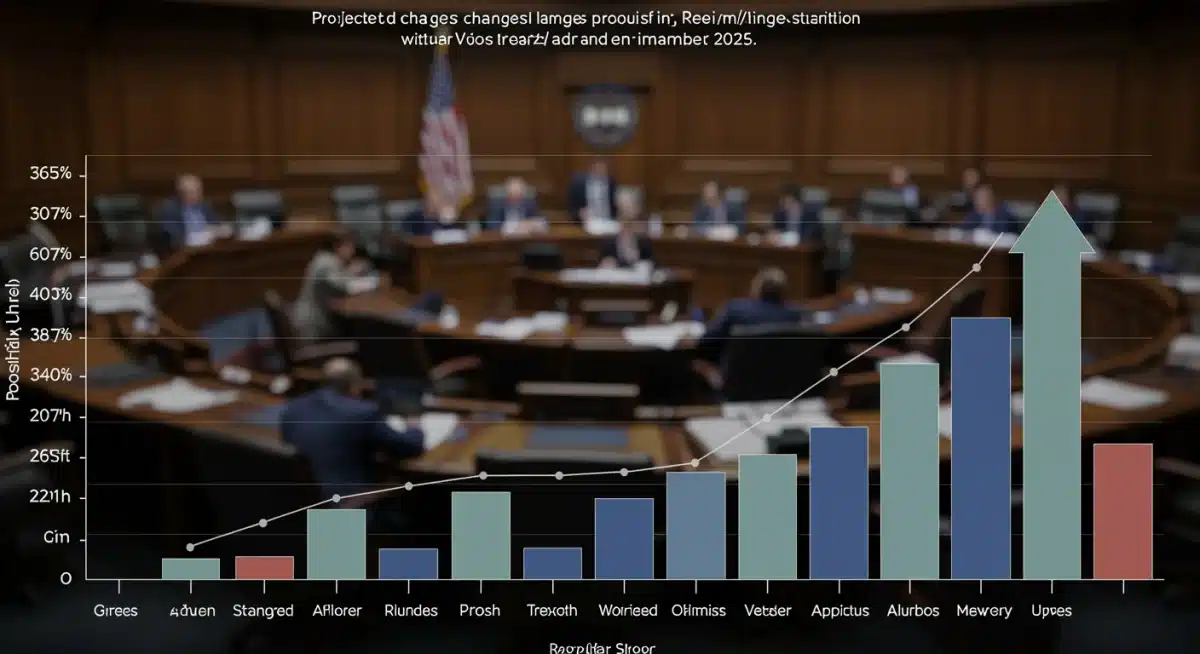Political Landscape 2025: Shifting Voter Demographics and Policy

Shifting voter demographics in 2025 are set to profoundly reshape national policy over the next four years, influencing everything from economic strategies to social programs and environmental regulations.
The Political Landscape 2025: How Shifting Voter Demographics Will Influence National Policy Over the Next 4 Years is rapidly evolving, driven by profound changes in who votes and what issues matter most to them. What do these demographic shifts mean for the future of national policy?
Understanding the Shifting Electorate
The electorate is not a static entity; it is a dynamic mosaic constantly reconfiguring itself. As of early 2025, new analyses highlight significant movements within key voting blocs, signaling potential shifts in political power and policy priorities. These changes are not just about numbers but about the evolving values and demands of a diverse population.
Understanding these demographic shifts is crucial for anticipating future policy directions. Political parties and policymakers are already beginning to adjust their strategies, recognizing that the voters of today and tomorrow have different concerns and expectations than those of a decade ago.
Generational Realignment
One of the most impactful shifts is the ongoing generational realignment. Younger voters, particularly Gen Z and Millennials, now represent a substantial portion of the eligible electorate. Their political engagement, issue priorities, and preferred modes of communication differ significantly from older generations.
- Youth Engagement: Increased participation rates among younger voters in recent elections.
- Digital Natives: Reliance on social media and digital platforms for political information and organization.
- Progressive Stance: Tendency toward more progressive views on social and environmental issues.
- Economic Concerns: High focus on economic equity, student debt, and affordable housing.
Racial and Ethnic Diversity
The United States continues to grow more racially and ethnically diverse. This demographic trend is directly impacting the electorate, with minority groups constituting an ever-larger share of voters. This growing diversity brings with it a wider range of experiences and policy preferences to the political arena.
The expanding influence of Hispanic, Asian, and Black voters, among others, is forcing a reevaluation of campaign strategies and policy platforms. Issues such as immigration reform, racial justice, and equitable access to healthcare and education are gaining prominence as these groups exert their collective power.
Economic Policy in a New Demographic Era
The evolving voter base is placing new pressures on economic policy. As younger and more diverse populations gain political sway, traditional economic approaches are being challenged, leading to calls for more inclusive and equitable systems. The focus is shifting from broad economic growth to how that growth is distributed across different segments of society.
Policymakers are now contending with a generation burdened by student debt and facing unprecedented housing costs. This has fueled demands for policies that address wealth inequality, promote fair labor practices, and expand access to affordable education and healthcare.
Redefining Economic Priorities
The emphasis on economic justice is driving discussions around new policy frameworks. These frameworks often include proposals for universal basic income, expanded social safety nets, and investments in green economies that promise both jobs and environmental benefits.
- Wealth Redistribution: Calls for higher taxes on corporations and high-income earners.
- Labor Rights: Increased support for unionization and worker protections.
- Affordable Living: Policies aimed at lowering housing costs and expanding access to affordable healthcare.
- Green Economy: Investments in renewable energy and sustainable industries to create new jobs.

The impact of these demographic shifts extends to fiscal policy, with debates intensifying over government spending, deficit reduction, and the role of public investment. The expectation is that future economic policies will reflect a stronger emphasis on social welfare and long-term sustainability rather than solely short-term growth metrics.
Social and Cultural Policy Realignments
Beyond economics, the shifting voter demographics are profoundly influencing social and cultural policy debates. Issues that were once considered niche are now central to political discourse, reflecting the diverse values and identities of the modern electorate. This includes discussions around identity, equality, and individual freedoms.
The rising influence of younger, more diverse voters has pushed issues such as LGBTQ+ rights, reproductive freedoms, and racial justice to the forefront. These groups often champion policies that promote inclusivity and challenge traditional social norms, leading to significant policy realignments.
Evolving Social Justice Agendas
The push for social justice is manifesting in various policy areas. From criminal justice reform to educational curricula, the demand for policies that address historical inequalities and promote equitable treatment is growing stronger. This is creating new challenges and opportunities for political leaders.
- Criminal Justice Reform: Policies aimed at reducing incarceration rates and addressing systemic biases.
- Reproductive Rights: Continued debates and legislative efforts regarding access to abortion and reproductive healthcare.
- LGBTQ+ Protections: Expansion of anti-discrimination laws and recognition of diverse gender identities.
- Education Equity: Reforms to ensure equitable access to quality education for all students.
These evolving social and cultural priorities are not just confined to legislative chambers; they are also shaping public discourse and influencing corporate practices. Companies and institutions are increasingly expected to align with these progressive values, reflecting the broader societal shifts driven by demographic change.
Environmental Policy and Climate Action
Climate change and environmental protection have emerged as critical issues for a significant portion of the electorate, particularly younger voters. The urgency of addressing environmental challenges is now a major factor in how voters assess candidates and parties, directly impacting environmental policy over the next four years.
The growing awareness of climate impacts, coupled with a desire for sustainable living, is driving demand for ambitious environmental policies. This includes investments in renewable energy, stricter regulations on pollution, and international cooperation to combat global warming.
Driving Green Initiatives
The demographic push for environmental action is translating into concrete policy proposals. Governments are facing increased pressure to commit to net-zero emissions targets, invest in green infrastructure, and protect natural resources. This shift is set to redefine energy policy and industrial regulations.
- Renewable Energy Targets: Mandates for transitioning to solar, wind, and other clean energy sources.
- Carbon Pricing: Implementation of carbon taxes or cap-and-trade systems to reduce emissions.
- Conservation Efforts: Policies focused on protecting biodiversity and natural ecosystems.
- Sustainable Agriculture: Promotion of environmentally friendly farming practices.
The economic implications of these environmental policies are also a key consideration. While some fear economic disruption, proponents argue that investments in green technologies and sustainable practices will create new jobs and foster long-term economic resilience.
Healthcare and Public Health Priorities
Healthcare remains a top concern for many voters, and demographic shifts are reshaping the debate around access, affordability, and public health infrastructure. An aging population, coupled with the health challenges faced by diverse communities, is pushing for comprehensive reforms in healthcare policy.
The COVID-19 pandemic highlighted existing disparities in healthcare access and outcomes, further galvanizing calls for more equitable systems. Younger voters and minority groups often advocate for universal healthcare models and robust public health initiatives.
Reforming Healthcare Access
Future healthcare policies are expected to focus on expanding coverage, reducing costs, and addressing health inequities. This includes discussions on strengthening the Affordable Care Act, exploring single-payer systems, and investing in preventative care.
- Universal Coverage: Debates around expanding Medicare, Medicaid, or implementing a public option.
- Prescription Drug Costs: Policies aimed at lowering the price of essential medications.
- Mental Health Services: Increased funding and accessibility for mental health and addiction treatment.
- Health Equity: Initiatives to address disparities in health outcomes based on race, income, and geography.
The role of technology in healthcare is also evolving, with greater emphasis on telehealth services, digital health records, and data-driven public health interventions. These advancements are expected to play a crucial role in delivering more efficient and accessible healthcare.
Immigration and Foreign Policy Considerations
Immigration policy, a perennially contentious issue, is also being reshaped by demographic changes. As immigrant communities grow and become more politically active, their voices are increasingly influencing national debates on border security, pathways to citizenship, and integration policies.
The humanitarian aspects of immigration, along with its economic and cultural contributions, are gaining prominence. This is leading to calls for more comprehensive and compassionate immigration reforms that balance national security with human rights.
Evolving Immigration Debates
Future immigration policies are likely to reflect a more nuanced approach, moving beyond solely enforcement-based strategies. There will be increased pressure to address the root causes of migration, streamline legal immigration processes, and provide clear pathways for undocumented individuals.
- Border Management: Discussions on smart border technologies and humanitarian approaches.
- Citizenship Pathways: Proposals for comprehensive immigration reform providing routes to legal status.
- Refugee Resettlement: Policies on welcoming and integrating refugees and asylum seekers.
- Economic Integration: Programs supporting immigrants’ contributions to the economy and society.
In foreign policy, the changing demographics may also influence international relations. A more diverse electorate might favor diplomatic engagement over military intervention, and prioritize global cooperation on issues such as climate change, human rights, and global health, reflecting a broader, more interconnected worldview.
| Key Policy Area | Demographic Influence |
|---|---|
| Economic Policy | Younger voters and diverse groups push for wealth redistribution, affordable living. |
| Social Policy | Increased focus on LGBTQ+ rights, racial justice, and reproductive freedoms. |
| Environmental Policy | Younger generations demand aggressive climate action and green investments. |
| Healthcare Policy | Aging population and diverse communities advocate for expanded coverage and equity. |
Frequently Asked Questions About 2025 Political Shifts
Generational shifts are expected to increase turnout among younger voters, who are more digitally engaged and focused on specific issues like climate change and economic equity. This could lead to a more progressive overall electorate.
Increased racial and ethnic diversity in the electorate will amplify calls for policies addressing systemic inequalities, immigration reform, and equitable access to resources, significantly shaping social and economic agendas.
Economic policies focused on wealth redistribution, affordable housing, student debt relief, and expanded social safety nets are likely to gain significant traction, driven by younger and more diverse voter groups.
New voter demographics, particularly younger generations, will push for more aggressive environmental policies, including investments in renewable energy, carbon reduction, and stronger conservation efforts to combat climate change.
Anticipated healthcare policy changes include efforts to expand universal coverage, reduce prescription drug costs, increase access to mental health services, and address health disparities across various demographic groups.
Looking Ahead
The shifting voter demographics in 2025 represent more than just a change in numbers; they signify a fundamental transformation in the political landscape. As these new voting blocs exert their influence, national policy across all sectors—from economics to social justice, environment, and healthcare—will continue to adapt. Policymakers and political parties are now grappling with the imperative to understand and respond to these evolving demands, setting the stage for a dynamic and potentially transformative period in national governance. The ongoing developments will shape the legislative agenda for years to come, reflecting a nation in constant demographic evolution.





